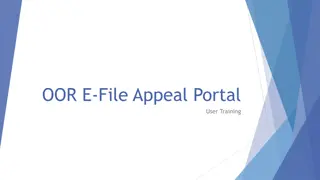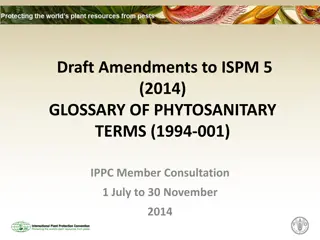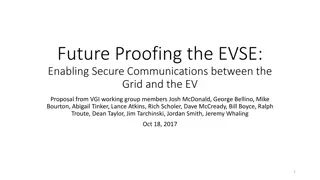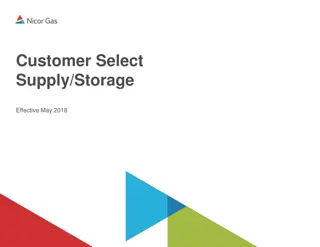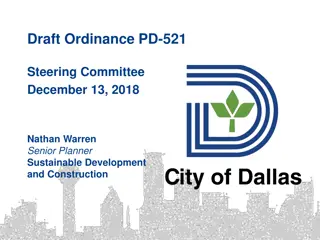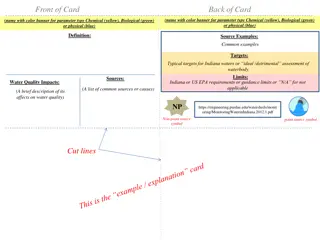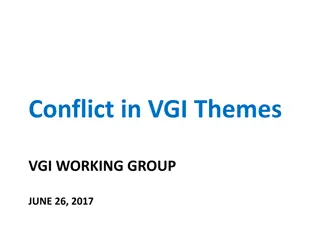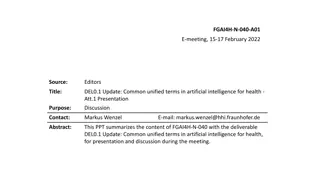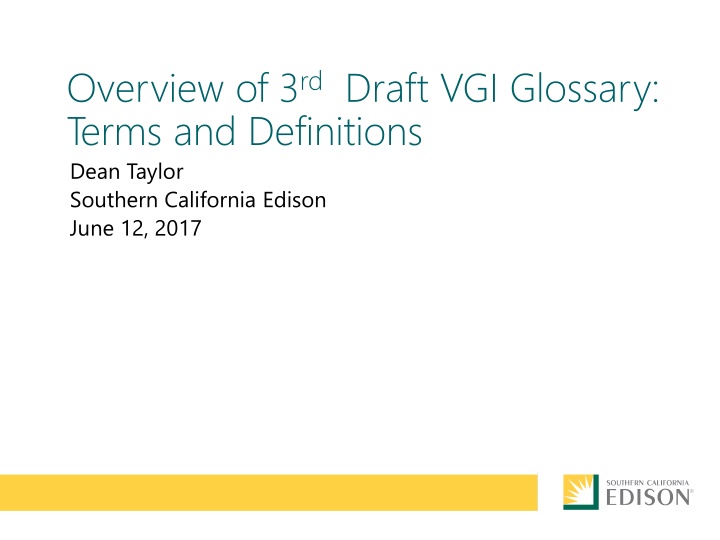
Overview of 3rd Draft VGI Glossary Terms and Definitions
This document provides an overview of the 3rd draft VGI Glossary, including the need for collaboration among industries, updates on new definitions, frameworks for organizing deliverables, and a benefit matrix drawn from energy storage frameworks. The glossary aims to be a living document with continuous additions and improvements.
Download Presentation

Please find below an Image/Link to download the presentation.
The content on the website is provided AS IS for your information and personal use only. It may not be sold, licensed, or shared on other websites without obtaining consent from the author. If you encounter any issues during the download, it is possible that the publisher has removed the file from their server.
You are allowed to download the files provided on this website for personal or commercial use, subject to the condition that they are used lawfully. All files are the property of their respective owners.
The content on the website is provided AS IS for your information and personal use only. It may not be sold, licensed, or shared on other websites without obtaining consent from the author.
E N D
Presentation Transcript
Overview of 3rdDraft VGI Glossary: Terms and Definitions Dean Taylor Southern California Edison June 12, 2017
Overview Three industries and several regulators need to come together, understand each other and share a common customer Existing glossaries were used as much as possible, but could be missing several 3rd Draft is a work-in-progress sent to google-groups and posted on google-drive on June 11 Since May 30 meeting Received request to define about 90 new terms. Added large section explaining the standards Added about 60 definitions Glossary should be living document Send e-mail to Dean.Taylor@sce.com to join subgroup Future drafts to be posted on the google-groups site and separate folder on the google-drive site 1 Southern California Edison
New definitions still to be added Late on June 9, the subgroup was provided new reports and glossaries to review IDER Competitive Solicitation Framework Working group final report (CPUC August 2016) Storage Multi-Use Application CPUC whitepaper (May 2017) CAISO glossary 2016 (Business Practice Manual for Definitions and Acronyms) Over the weekend many new definitions were provided, but they have not been added to the 3rd draft After draft 4 we ll have a call of the subgroup the week of June 19 to review and add a few definitions 2 Southern California Edison
Possible Frameworks / Structures for Organizing Use Cases / Deliverables VGI white paper framework (CPUC 2013) Adam Langton s framework (to be updated based on June 8 call) Abigail Tinker s framework Storage Multi-Use Application whitepaper (May 2017 CPUC) 3rd Draft Glossary has five more frameworks (see slides 9 to 11) E3 s framework (see next slides) 3 Southern California Edison
E3s VGI Benefit Matrix Drawn from energy storage, electric vehicle and smart grid frameworks Not exhaustively comprehensive, but intended to emphasize: Mutually exclusive definitions Focus on high value benefits Different approaches to quantifying benefit value Planning Model with Operational Requirements Capital Expansion Stochastic Production Simulation Integrated Distributed Energy Resource modeling Individual Asset Dispatch Optimization Distribution/Power Flow Modeling 4 Southern California Edison
E3 VGI Benefits Framework: Planning & Capacity VGI Services Category Customer/ Driver Renewable and GHG Distribution Transmission Generation Reduced portfolio procurement costs to meet forecasted load and reliaiblity targets Reduced portfolio procurement costs to meet RPS and GHG targets Reduce Long-term Distribution Resource Plan Costs Planning & Procurement Reduced procurement of Ancillary Services Improve Customer Reliability/Back-up Power Distribution Investment Deferral (Reliability) Reduce NERC N-1 Contingency Important distinction between utility planning and policy goals Reliability Islanding System Generation Capacity (Reduce LOLP) Broad reduction of load growth related infrastructure upgrade costs Renewable Firming (Increase NQC/ELCC) Targeted placement for high value deferrals (e.g. Non-Wires Alternatives and Local Integrated Resource Plans) Local Generation Capacity (Reduce LOLP) Targeted Deployment Capacity Demand Charge Reduction Transmission Access Charge Reduction Flexible Capacity Option Value (Modularity) 5 Southern California Edison
E3 VGI Benefits Framework: Operational VGI Services Category Renewable and GHG Customer/ Driver Distribution Transmission Generation TOU Energy Charge Reduction Distribution Peak Shaving Reduce Transmission Congestion Wholesale Time Shift/Arbitrage Renewable Generation Time Shift Time Shfit Option value (Volatility) Option value (Volatility) Reduce Renewable Curtailment Backflow Prevention Unit Commitment/Start Up Cost Reduction Efficiency Improvement/ Emissions Reduction Generation Operation Reduce System Production Cost O&M Reduction/Equipment Life Extension $ values for T&D operating benefits have been hard to generalize and small relative to other categories Loss Reduction Renewable Power Smoothing Voltage Support Transmission & Distribution Operations Power Factor Improvement/Loss Reduction Renewable Generation Power Factor Improvement Customer Power Factor Improvement VAR Support Distribution Investment Deferral (Power Quality) Improve Customer Power Quality Increase Renewable DG Hosting Capacity 6 Southern California Edison
E3 VGI Benefits Framework: Operating AS Category Description Service Inherent in the system due to rotating characteristic of conventional generation (synchronous generators). The Inertial Frequency Response provides counter response within seconds to arrest the frequency deviation. Inertial Frequency Response The instantaneous proportional increase or decrease in real power output in response to system frequency deviations. The Primary Frequency Response is generally delivered completely within 14 seconds. Primary Frequency Response Existing Markets (for loads) Fast/Accurate Frequency Regulation Provide AGC frequency regulation in AS markets that is faster and more accurate than traditional generation resources Executed by Automatic Generation Control (AGC) . The AGC system deploys regulating reserves to restore the frequency closer to scheduled frequency. AGC action can take anywhere from seconds to minutes depending on the resource Frequency Regulation (Secondary) Operating Ancillary Services Real-Time/Balancing Energy Energy dispatched directed by the grid operator every 5-10 minutes to balance load and generation within the hour Ability to rapidly increase or decrease output (measured in MW/Min) to manage uncertainty and forecast error for generation and load Ramp (MW/min) balancing load and generation in the 5-60 minute time frame between 5 minute imbalance energy and hourly real-time energy markets (e.g. CAISO Flexi-Ramp and FRAC-MOO) Load Following (5 - 60 minutes) Increase generation over multiple hours, typically considered for morning and evening hours when large increases/decreases in net load are expected over several hours. Hour to Hour Ramp 7 Southern California Edison
E3 VGI Benefits Framework: Contingency AS Category Description Service Generation (or responsive load) that is ready to respond immediately, in case a generator or transmission line fails unexpectedly. Spinning reserve begins to respond immediately and must fully respond within ten minutes. ISO rules differ on whether 10 minute reserves must be synchronized to the grid Sync/Spinning Reserve Contingency Reserves Similar to spinning reserve, except that the resource is not necessarily required to be synchronized to the grid and the response does not need to begin immediately. Full response is generally required within 10 to 30 minutes. Non-spinning Reserve Replacement Reserve An additional reserve required in some regions. It begins responding in 30 to 60 minutes. Mutually exhaustive definitions Focus initially on high value benefits that easily generalized Define how $ benefits are to be quantified 8 Southern California Edison
VGI Benefit Groupings Draft Option 1 Wholesale market services (ISO / RTO): 1) frequency regulation, 2) spinning, non-spinning and supplemental reserve, 3) load following / ramping support for renewables 4) capacity markets 5) Demand Response Auction Mechanism 6) real-time and day-ahead energy markets 7) energy arbitrage 8) black start, 9) voltage and/or reactive power support Distribution infrastructure benefits: 1) distribution upgrade deferral 2) local distributed generation support 3) peak load shedding: 4) resource adequacy? DSO / utility market benefits: 1) DERMS, 2) ADMS; 3) Rule 21 smart inverter management Customer facing benefits: 1) retail energy time shift with rates, 2) demand leveling with rates or controls, 3) power quality, 4) power reliability, 5) monetizing of GHG and air pollution reduction benefits, 6) maximizing customer use of renewable generation 7) demand leveling with BMS or parking lot EVEMS 8) back-up power Societal benefits: 1) adoption of EVs, 2) low-cost reductions in GHG and air pollutants, 3) low cost of EV ownership, 4) net jobs 9 Southern California Edison
Other Draft Options for Grouping VGI VGI Beneficiary groupings (option 2) by level Site host / customer benefits - includes commercial and residential situations including homes All utility customer benefits TBD ISO whole sale market benefits - TBD DSO / utility markets TBD Societal benefits TBD VGI grouping (option 3) Wholesale market solutions TBD DSO / utility markets TBD Non-market solutions TBD VGI benefit grouping (option 4) by value category Reducing energy generation cost - TBD Reducing site hosts and EV driver s electric bills - TBD Deferring distribution upgrades - TBD Improving reliability - TBD Aligning EV load with renewable integration - TBD Measuring fuel switching gasoline to EV (required by Low Carbon Fuel Standard for non-residential charging) 10 Southern California Edison
Another grouping option (6) VGI types Charging level incentives (foundational) Tools include rebates for lower level charging, modifying current allowance policy, demand charge design TOU Rate Design and Adoption Policy (foundational) Tools include TOU rate design and policies to require or encourage TOU rate adoption for EVs V1G (or managed or controlled charging): Unidirectional power flow under central or customer control enabling vehicles to charge and provide wholesale market services. Includes varying the charge rate at the charging station, EV management system, parking lot EV Energy management system or building management system in order to provide demand response, ancillary services or other market services. V2G Similar to V1G but bidirectional power flow to the grid. (we have two lengthy alternative definitions in glossary) 11 Southern California Edison
Thank you 12
Appendix 13 Southern California Edison
Used Existing Glossaries to large extent 1. VGI White paper, CPUC Energy Division 2. California VGI Roadmap, Cal-ISO with CPUC & CEC 3. Modern Distribution Grid 2017, Vol 1, USDOE 4. Electrical Energy Storage, CPUC Planning and Policy Division report 5. 2020 Strategic Analysis of Energy Storage in CA, CEC 6. Energy Storage Phase 2 Interim Staff Report, CPUC Energy Division 7. Battery Storage Economics, Rocky Mountain Institute 8. Engaging Utilities in TE in the U.S., Europe and China, E3 9. Glossary of Definitions, North America Energy Reliability Council 14 Southern California Edison
More 3rd draft terms and definitions Short-dwell or opportunity charging locations: locations where a vehicle is parked for a few minutes or few hours and can charge. An EV may or may not need a charge at these locations. Examples include charging at restaurants, retail, rest- stops, gas stations, doctors, dentists and similar service providers Long-dwell charging locations: locations where vehicles are typically parked for more than four hours and can charge. Examples includes homes, workplaces, fleets, destination centers and mixed-use locations Fleet charging: charging stations for a business s own commercial EVs Workplace Charging: charging stations for a employees, staff, students, teachers, professors (but not visitors) Destination Center Charging: Charging stations located at sites that attract longer distance trips including, but not limited to, hotels, resorts, theme parks, major malls, parks, beaches, theaters, sports centers, concert halls, casinos Multi-unit dwelling charging: refers to charging stations in common areas of condos and apartments (usually a commercial account for a utility) 15 Southern California Edison
More 3rd draft terms and definitions Single family home charging: Charging stations in driveways, carports or garages in residences designed for individuals or a family. Includes both attached and detached homes, but excludes large apartment and condo complexes without individual garages or carports near the home. Urban DC fast charging plaza: large cluster of away-from-home, public-access, DC fast charge stations in urban and suburban areas (could be on a travel corridor or not) Corridor DC fast charging plaza: large cluster of away-from-home, public access, DC fast charge stations away-from urban areas along travel corridors Restaurant, retail and rest-stop charging (can be level 1, 2 or DC) includes small clusters of charging at those locations but excludes large scale charging plazas Mixed use charging: charging where multiple types of users typically charge. For example, city parking structures used by residents of MUDs, workplaces, city fleet vehicles and visitor to regional destination centers Street or curbside charging: Charging stations (AC or DC) on a curb 16 Southern California Edison
Use case draft definition Use case: Defines a grid problem that can be solved with one or more solutions (technical and/or non-technical) and describes the solutions. Use cases are generally vision documents that help clarify a goal or vision of a project or a solution including its usefulness. Use Case is a list of actions or event steps, typically defining the interactions between Actor(s) or Role(s) and a system, to achieve a goal means that each use case has to be tied to a specific value it is providing (i.e. describe how it is producing that value). Typically VGI use case questions include: Is VGI operationally viable for this use? What are the potential benefits of VGI in this use case? Can these benefits be monetized via existing market structure? If not, how should they be valued? Is VGI cost-effective for this use? What barriers or trade-offs are preventing or slowing deployment of VGI in this use? What are the policy options to address the identified barriers or trade- offs encountered by VGI implementation? Should procurement targets or other policies to encourage VGI be considered for this use? Note above definition was modified from #6: Energy Storage Phase 2 staff report 17 Southern California Edison
1st Draft terms and definitions Charging station manufacturer: company that makes the charging station Charging station maintainer: company that provides repair and maintenance service to the charging stations and may only provide that service Charging station installer: company that provides installation service and may only provide that service Charging infrastructure provider: company or companies that provides the electrical and civil work associated with the make-ready and utility side infrastructure for the charging station Charging station services provider: provides services to the owner of the charging station but the number of services may depend on the package selected or vary between different companies in the market Charging Station Operator (CSO): the charging station operator installs, operates and maintains the EVSE to facilitate a reliable charging experience for PEV owners. (aka Charge Spot Operator or charge point operator) (from glossary #8) Charging network operator: provides services including ISO wholesale market services 18 Southern California Edison
1st Draft Terms and Definitions Charging station / device: The off-board-the-EV unit that contains a charging connector that is used to insert into the EV. This is a broad term that may include AC, DC, inductive (e.g. wireless) or conductive charging and may include or exclude the charger Charging plaza or center: is large collection of public-access charging stations Make-ready: refers to the behind-the-meter infrastructure up-to stub, but not including charging station or the utility side equipment. It typically the does not utility meter or charging station, but may include hardware (panel, trenching, wiring) and civil work (trenching, planning, installation) Traditional utility distribution service equipment or utility side-of- the meter infrastructure: includes the meter, overhead or underground service to the meter, transformer upgrade, etc. Charging infrastructure includes the make-ready and the utility- side-of the meter infrastructure, but not include charging station 19 Southern California Edison
High level 1st draft terms and definitions VGI Vehicle Grid Integration very broad term that encompasses the many ways in which an EV can provide benefits or services to the grid and bring benefit to society optimizing EV interaction with the grid Technical solutions: VGI solutions that need a communication protocol. Non-Technical or foundational solutions: VGI solutions that do not need a communication protocol (e.g. rates, charging station rebates, allowances, fuel switching measurement) Market services: TBD - probably means ISO wholesale market and DSO / utility market Non-market services and benefits: TBD - probably same as non-technical 20 Southern California Edison



